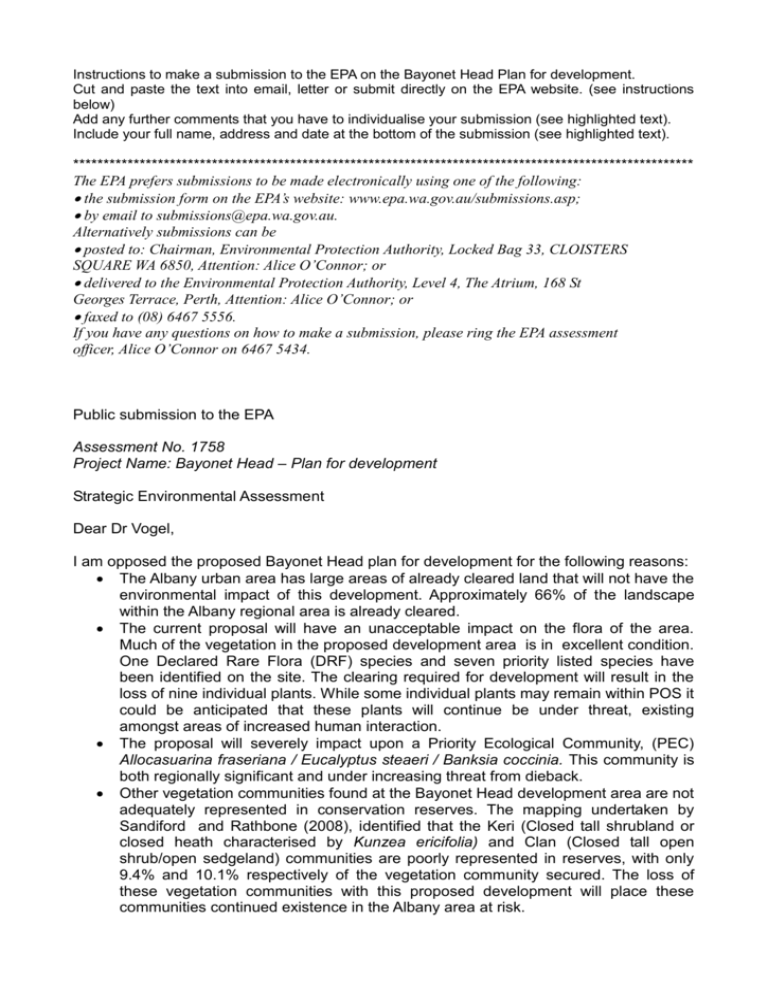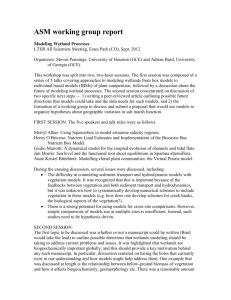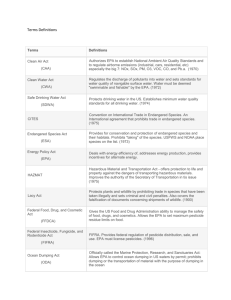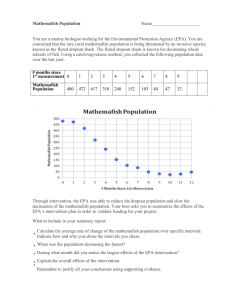Bayonet Head_submission_individual
advertisement

Instructions to make a submission to the EPA on the Bayonet Head Plan for development. Cut and paste the text into email, letter or submit directly on the EPA website. (see instructions below) Add any further comments that you have to individualise your submission (see highlighted text). Include your full name, address and date at the bottom of the submission (see highlighted text). ******************************************************************************************************* The EPA prefers submissions to be made electronically using one of the following: the submission form on the EPA’s website: www.epa.wa.gov.au/submissions.asp; by email to submissions@epa.wa.gov.au. Alternatively submissions can be posted to: Chairman, Environmental Protection Authority, Locked Bag 33, CLOISTERS SQUARE WA 6850, Attention: Alice O’Connor; or delivered to the Environmental Protection Authority, Level 4, The Atrium, 168 St Georges Terrace, Perth, Attention: Alice O’Connor; or faxed to (08) 6467 5556. If you have any questions on how to make a submission, please ring the EPA assessment officer, Alice O’Connor on 6467 5434. Public submission to the EPA Assessment No. 1758 Project Name: Bayonet Head – Plan for development Strategic Environmental Assessment Dear Dr Vogel, I am opposed the proposed Bayonet Head plan for development for the following reasons: The Albany urban area has large areas of already cleared land that will not have the environmental impact of this development. Approximately 66% of the landscape within the Albany regional area is already cleared. The current proposal will have an unacceptable impact on the flora of the area. Much of the vegetation in the proposed development area is in excellent condition. One Declared Rare Flora (DRF) species and seven priority listed species have been identified on the site. The clearing required for development will result in the loss of nine individual plants. While some individual plants may remain within POS it could be anticipated that these plants will continue be under threat, existing amongst areas of increased human interaction. The proposal will severely impact upon a Priority Ecological Community, (PEC) Allocasuarina fraseriana / Eucalyptus steaeri / Banksia coccinia. This community is both regionally significant and under increasing threat from dieback. Other vegetation communities found at the Bayonet Head development area are not adequately represented in conservation reserves. The mapping undertaken by Sandiford and Rathbone (2008), identified that the Keri (Closed tall shrubland or closed heath characterised by Kunzea ericifolia) and Clan (Closed tall open shrub/open sedgeland) communities are poorly represented in reserves, with only 9.4% and 10.1% respectively of the vegetation community secured. The loss of these vegetation communities with this proposed development will place these communities continued existence in the Albany area at risk. The fragmentation of the bushland that is proposed to be retained in the Public Open Space areas, will not be supportive to the long term survival of the remnants. The remnants will face pressure from encroachment of weeds, increased pedestrian traffic, fire and Pc dieback. As the bushland goes, then inevitably, will the fauna that depends upon it. The loss of nearly 100ha of high quality remnant vegetation will have a significant impact on local fauna. The proposed development will result in loss of habitat for fauna listed under Commonwealth legislation, the Environmental Protection and Biodiversity Conservation Act 1999. Two species, the Western Ringtail Possum and White-tailed Black Cockatoos are likely to be significantly impacted by the proposed development. For the Western Ringtail Possum, Albany is at the eastern extent of the animals range. The loss of significant areas of foraging habitat and nesting sites will reduce the viability of these possums in this area. For the White-tailed Black Cockatoos (both Baudins and Carnabys species) this proposal will mean the loss of a significant feeding and nesting area. The proposed development plans to protect token nesting areas, but limited areas of suitable food sources. The remaining trees, isolated from the protection of the surrounding vegetation, will inevitably succumb to dieback, fire, or “over-management” - the impact of human intervention. There are also several species listed under the Western Australian Wildlife Conservation Act 1950. The Bandicoot and the Western false pipistrelle are both priority species listed under this Act, and both species will suffer with the loss and fragmentation of habitat. All remaining birds and animals, not just the threatened species, will be further stressed with the impact of human settlement. Human incursions into bush areas, and the threats of vehicles and domestic animals will be the final nails in the coffins of all urban wildlife. The proposal suggests that a few scattered Public Open Space areas are “consolidated, manageable areas with a linear stepping stone function”. The reality is that this design will do nothing to facilitate the movement of fauna. The small remnants, with oceans of sterile human environment in between, will ensure that the remaining fauna, and flora, will remain biologically isolated in POS “islands”. The proposed development boundary includes a number of wetlands (six conservation category wetlands) that have important conservation values which also form linkages with the nearby Oyster Harbour and upland areas. The proposal does not provide sufficient protection for the majority of these wetlands and the requirement for stormwater management in the proposed development is not fully compatible with protection of the wetlands current and future conservation potential. While buffer areas are identified for some of the wetlands, it is not known whether that buffer distance is sufficient to protect the hydrological and ecological values associated with the wetlands. Please add any further comments that you may have Yours sincerely, Name Address Date









